
6 minute read
Wrapping Up Savings

A reusable insulation blanket designed for and installed on a wood boiler at one of Horizon Health Network's regional hospitals.
Advertisement
New Brunswick hospital gets quick payback from blanketing energy loss
By Bill Perry
Thanks to a one-time investment in reusable insulation blankets, the boiler plant at Horizon Health Network’s Miramichi Regional Hospital (MRH) has reduced its steam consumption by approximately 15 million pounds since April 2015. According to its manufacturer, the reusable insulation should last at least another 10 years. So, during the next decade, the New Brunswick hospital expects to save another 30 million pounds of steam.
DIAGNOSING ENERGY LOSS While researching opportunities for energy savings in its 12 hospitals, Horizon learned of a low-cost opportunity to reduce heat loss in steam systems by installing industrial insulation. According to the U.S. Department of Energy, installing a oneinch thick blanket on an uninsulated sixinch gate valve in a 250-pounds per square
inch gauge (psig) saturated steam line yields a savings of $525 per year. In 2014, an audit of MRH’s steam system was performed by a company that designs and makes reusable thermal and acoustic insulation blankets. The audit involved tracing the steam system and calculating thermal energy loss from exposed surfaces, such as valves and fittings in the boiler room, among other places. It predicted that covering steam system components with reusable insulation would reduce steam consumption by approximately one million pounds annually.
“The value of a reusable blanket is clear the first time a maintenance worker accesses a component for service,” says Todd Bryenton, energy coordinator and chief engineer at MRH. “Conventional fibreglass insulation wrapped around certain points of a steam system will initially realize heat loss reduction; however, when a component like a pump requires maintenance, the fibreglass insulation will be removed, typically thrown out, and the component is left bare because there’s no easy way to replace the insulation.”
While finding an affordable energy-saving solution was a motivation for the insulation project, staff at the hospital also saw an opportunity to improve safety.
“Insulation systems appear to be simple but doing them correctly can be complex,” says John Puskar, an expert on North American codes and standards related to piping, furnaces and boilers. “Everything on a piping system should be insulated, including fittings. The most popular method is to use flexible, reusable covers custom-fit for an application.” According to Puskar, insulating steam piping prevents excessive condensate from overloading steam traps. In the case of
water lines, insulation prevents dew point conditions and accelerated corrosion. While piping is commonly insulated, valves, flanges and pumps are not.
“High temperature and pressure applications can cause an insulation blanket’s fasteners to fail, unless designed by a supplier that accounts for the added heat,” he says.
INSTALLATION AND MEASUREMENT Working with the maker of the reusable insulation system for MRH, hospital maintenance staff installed the insulation blankets in the boiler plant, including areas such as the main header, instantaneous heater and condensate pumps. Prior to this, the insulation at MRH was largely confined to the facility’s steam system pipes, so the system’s fittings were typically not covered.
After installation, Horizon used an energy management information system to measure and verify the steam reduction. To determine the initial (and ongoing) steam reduction from the reusable blankets, Kate Butler from Service New Brunswick’s health services energy management team analyzed the total steam produced from April-June 2015, and compared that to April-June 2014, using a weather normalized data analysis for two different baseline years (for example, fiscal years 2011-2012 and 2014-2015). She then compared this information to the actual steam production after the installation of the reusable blankets (April-June 2015). The annual cost avoidance in MRH’s boiler plant was measured and verified to be nearly three times greater than the one predicted by the audit.
RETHINKING REUSE According to Tim Janos, director of special projects for the Association of Energy Engineers, some facility managers forgo insulating valves and other complex fittings because they know maintenance staff need to access components. If the insulation isn’t reusable, says Janos, workers will cut it off and throw it away. But leaving a component bare is a potential safety risk.
With its reusable insulation program, Horizon’s focus was on safety, standards and reusability. This ensured the blankets would not only prevent heat loss but also be easily replaced by maintenance staff once
removed, thus sustaining the energy reduction and safety. For its project, MRH decided on the following blanket standards: non-flammable; 38 millimetres in thickness to ensure exterior temperature of blankets is under 49 C; 11 pounds per cubic foot fibreglass needled mat, type E fibre (blanket insulation material); Polytetrafluoroethylene (PTFE) impregnated fibreglass cloth (blanket surface material), including metal identification tag; Velcro and strap fasteners for easily opening and closing blankets; double-sewn lock stitch for durability and PTFE-coated fibreglass thread; thread that would not melt and a break point equal to 15.8 kilograms; and stainless steel grommet to drain liquid from the low point of any blanket installed in a wet area.
By requesting a product that met these specifications, it would be thick enough to insulate components and protect workers from burns, while mitigating a buildup of condensate and preventing mildew and mould from forming around components.
THE JUSTIFICATION FOR EXPANSION Since implementing reusable insulation blankets in MRH’s boiler room, the mechanics who work in the space have noted a significant drop in temperature near the wood-fired boiler and components. The measurement and verification data collected by staff quantified that temperature drop, directly correlating the reduction to the installation.
Saving energy and preventing risk is possible with the reusable blankets, in part, because MRH staff can easily remove and reuse the insulation. The custom-fitted blankets have a look and shape, even when removed from a component, that mirrors the geometry of the part on which each belongs. When maintenance workers remove blankets fitted for nearly identical components, they can reference a metal identification tag affixed to the blanket that describes the component and location.
As the measurement and verification survey has shown, if a facility accurately identifies areas of heat loss and correctly designs and uses reusable insulation, the cost of ownership is little to none. The installation of reusable blankets on components beyond piping highlights the solution’s ability to reduce a steam system’s energy loss. For example, by blanketing steam traps, which separate condensate from water, facilities staff can ensure these components do not clog and lose steam. Having reusable blankets for a steam trap or pump ensures maintenance crews can easily remove them, evaluate the component and put insulation back on, which reduces energy loss.
According to experts, a proper steam system audit is key to understanding exactly where the energy savings and payback opportunities lie. It’s also important to know how to compile the field data to present energy savings and get approval from utility rebate programs, if available. In Horizon’s case, rebates were not an option.
As MRH has proven, installing reusable blanket insulation reduces not only heat loss but also energy costs, greenhouse gas emissions and safety risks for workers. Because of the project’s success, Horizon has installed reusable insulation at three more of its hospitals.
Bill Perry is director of content development for Shannon Global Energy Solutions, which designed and manufactured the reusable insulation blankets for the Horizon Health Network’s Miramichi Regional Hospital. He can be reached at bperry@shannonglobalenergy.com.










